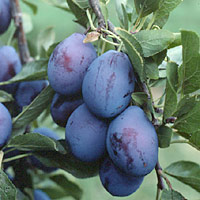Plum

Widely adapted, reliably prolific, more compact, and less demanding than most fruit trees, plums are a natural choice for the home grower. Plums are delicious cooked in jams, jellies, butters, sauces; baked in pies and coffee cakes; dried as prunes; or -- best of all -- eaten juicy fresh right off the tree. For the home gardener, plums offer an additional bonus: the trees add a beautiful, graceful touch to any home landscape.
About This Plant
Some plums are self-fertile but all plums will yield better if planted with a second variety for cross-pollination. Japanese plums need to cross-pollinate with other Japanese or American hybrid plums. Order bare-root, rather than potted trees, if possible. A well-established tree will yield up to 2 bushels of plums.
Site Selection
Select a site that offers loamy, well-drained soil in full sun. Avoid frost pockets.
Planting Instructions
Set bare-root trees atop a small mound of soil in the center of the planting hole, and spread the roots down and away without unduly bending them. Keep the graft union an inch above the soil line.
For container-grown trees, remove the plant from its pot and eliminate circling roots by laying the root ball on its side and cutting through the roots with shears. Don't cover the top of the root-ball with backfill because it could prevent water from entering.
Space standard-size varieties 20 to 25 feet apart, dwarfs 15 to 20 feet apart.
Care
Water young trees heavily every week through the first season. Train Japanese trees to an open center shape; train European trees to a conical shape with a central leader. Japanese plum trees benefit from a moderate fruit thinning; do not thin European plums unless the crop is especially heavy. Plums are relatively pest-free, but may be visited by the plum curculio, black knot disease, and brown rot. Contact your Cooperative Extension office for information on managing pests in your area.
Harvesting
Harvest European plums when they are tree-ripe. They will be a little soft and should come off easily with a slight twist. Late maturing varieties should be near ripe with firm flesh for storing for a few weeks. Pick Japanese plums slightly early and allow them to ripen in a cool place.






 Widely adapted, reliably prolific, more compact, and less demanding than most fruit trees, plums are a natural choice for the home grower. Plums are delicious cooked in jams, jellies, butters, sauces; baked in pies and coffee cakes; dried as prunes; or -- best of all -- eaten juicy fresh right off the tree. For the home gardener, plums offer an additional bonus: the trees add a beautiful, graceful touch to any home landscape.
Widely adapted, reliably prolific, more compact, and less demanding than most fruit trees, plums are a natural choice for the home grower. Plums are delicious cooked in jams, jellies, butters, sauces; baked in pies and coffee cakes; dried as prunes; or -- best of all -- eaten juicy fresh right off the tree. For the home gardener, plums offer an additional bonus: the trees add a beautiful, graceful touch to any home landscape.